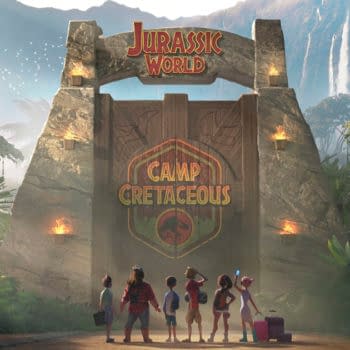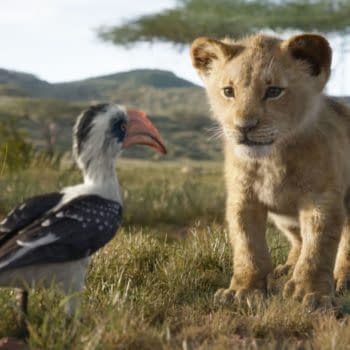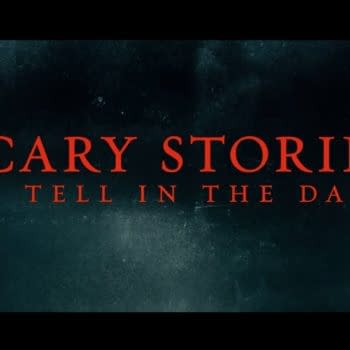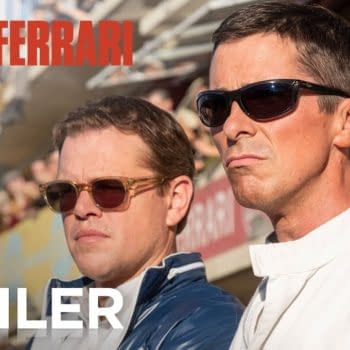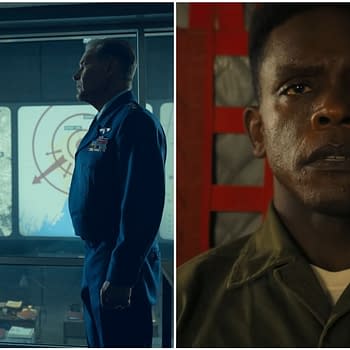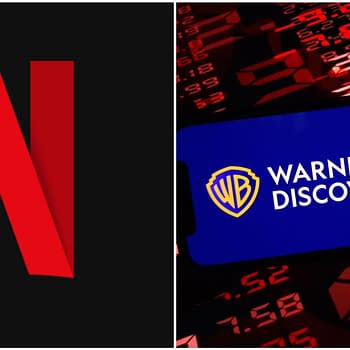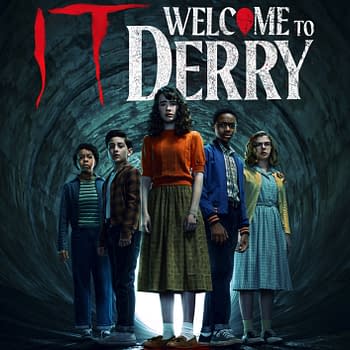Posted in: Movies | Tagged: Kill Bill, NYTimes, quentin tarantino, Uma Thurman
Quentin Tarantino Responds to Uma Thurman 'Kill Bill' Car Stunt Story
I thought that maybe after what actress Uma Thurman posted on her Instagram this morning, Quentin Tarantino would respond at some point. Namely, over the weekend, the NYTimes published a story where Thurman claimed a car "stunt" performed during Kill Bill almost cost her her life, and painted director Tarantino into a "bad guy" corner.

Tarantino has since responded in an interview with Deadline, going into details not mentioned in the NYTimes piece. He says that he and Thurman were far from enemies (even though he does confirm a two-year period where they didn't talk after the fact), having spoken at length before the piece was published about how she "wanted clarity" about the situation, and what his "role" was in the process.
The Deadline interview is lengthy; I'm going to post some of the first bits here so you can get an idea of the tone of it, and the link to the full text further down so you can get Quentin's version of what happened on the day in question:
DEADLINE: What was your initial reaction when you read that piece?
TARANTINO: I knew that the piece was happening. Uma and I had talked about it, for a long period of time, deciding how she was going to do it. She wanted clarity on what happened in that car crash, after all these years. She asked, could I get her the footage? I had to find it, 15 years later. We had to go through storage facilities, pulling out boxes. Shannon McIntosh found it. I couldn't believe it. I didn't think we were going to be able to find it. It was clear and it showed the crash and the aftermath. I was very happy to get it to Uma.
The thing is, Uma had people she wanted to indict, for that cover-up. Part of my job on the piece was to do an interview with Maureen Dowd, and back up Uma's claims. And we never hooked up. Me and Dowd never hooked up. I read the article and basically it seemed like all the other guys lawyered up, so they weren't even allowed to be named. And, through mostly Maureen Dowd's prose, I ended up taking the hit and taking the heat.
DEADLINE: Fair to say that when you gave Uma that footage, you expected it to be a visual aid in this article?
TARANTINO: I figured that eventually it would be used whenever she had her big piece. Also, there was an element of closure. She had been denied it, from Harvey Weinstein, being able to even see the footage. I wanted to deliver it to her, so she could look at it. So she could see it and help her with her memory of the incident. I never talked to Uma about this, but I don't exactly know exactly what cause the crash, and Uma doesn't know exactly what cause the crash. She has her suspicions and I have mine. I thought, if I get this footage to her and she puts it out there in the world, that a crash expert can look at it and determine exactly what happened on that road.
DEADLINE: You watched the footage published within the article. What's your feeling?
TARANTINO: See, all that is old news. I saw the footage when I found it. Seeing it in the article didn't do anything. Let me get right to what I want to get across. What happened that day that Uma got into that crash.
I remember this day very well. It was one of the last days of the shoot, and up until this point it was a great day. It was the second day of filming the Michael Parks scene, the Esteban Vihaio scene. He was amazing in the scene and so was Uma. Literally, the last shot of the day was going to be this driving shot. We wrapped up the Esteban Vihaio scene and we were very happy about it. It was in a weird dubious Mexican Cantina, and that was kind of exciting. We even had a New Yorker reporter, Larissa MacFarquhar, who almost went with us to the next shot. But since it was the last shot, and none of us thought it would be a big deal, she went home.
I start hearing from the production manager, Bennett Walsh, that Uma is trepidatious about doing the driving shot. None of us ever considered it a stunt. It was just driving. None of us looked at it as a stunt. Maybe we should have, but we didn't. I'm sure when it was brought up to me, that I rolled my eyes and was irritated. But I'm sure I wasn't in a rage and I wasn't livid. I didn't go barging into Uma's trailer, screaming at her to get into the car. I can imagine maybe rolling my eyes and thinking, we spent all this money taking this stick shift Karmann Ghia and changing the transmission, just for this shot. Anyone who knows Uma knows that going into her trailer, and screaming at her to do something is not the way to get her to do something. That's a bad tactic and I'd been shooting the movie with her for an entire year by this time. I would never react to her this way.
Instead, what happened was, I heard her trepidation. And despite that we had set up everything in this shot, I listened to it. What I did was, I drove down this road, this one lane little strip of road with foliage on either side, in Mexico. I drove down it, hoping against hope that it would be easy and safe enough for Uma to drive. So we're going down the road and I'm looking at it, watching it and I thought, this is going to be okay. This is a straight shot. There are no weird dips, there were no gully kinds of things, no hidden S-curves. Nothing like that. It was just a straight shot.
Uma had a license. I knew she was a shaky driver, but she had a license. When I was all finished [driving], I was very happy, thinking, she can totally do this, it won't be a problem. I go to Uma's trailer. Her makeup person, Ilona Herman was there. Far from me being mad, livid and angry, I was all…smiley. I said, Oh, Uma, it's just fine. You can totally do this. It's just a straight line, that's all it is. You get in the car at [point] number one, and drive to number two and you're all good.
DEADLINE: Didn't she have to drive fast?
TARANTINO: The idea was for her to drive around 30-45 mph, just to get the hair blowing. With all the foliage on either side, her driving 35 would seem like 60. But there were no obstacles, it was a straight shot.
I came in there all happy telling her she could totally do it, it was a straight line, you will have no problem. Uma's response was…"Okay." Because she believed me. Because she trusted me. I told her it would be okay. I told her the road was a straight line. I told her it would be safe. And it wasn't. I was wrong. I didn't force her into the car. She got into it because she trusted me. And she believed me.
So, it's decided she would get in the car. I had not heard about anything about a guy from transpo saying that the car didn't work. Which would be a strange thing for a guy from transpo to say, because they're the ones responsible for delivering safe vehicles. If a guy from transpo had something to say about an unsafe car, he should be telling the First AD, the production manager or the producer. Uma goes off to get ready. I go off, after my trip and talking to Uma, to number one, ready for her to show up. I arrive and then a question develops.
Would it be okay if we had the car drive the opposite direction? Because the lighting would be better because it was the end of the day. I'm guessing on this, but let's say we were going to do the car from east to west? Could we go from west to east? It didn't affect the shot. I didn't see how it would affect anything. A straight road is a straight road.
We changed our number one, so the car would be driving in the opposite direction from the way I had gone down. And that was the beginning of where the crash happened.
Here's the vid that Uma posted:
DEADLINE: You road tested it one way, and she drove the reverse way. It seemed from the footage that there was a twist right before she hit the tree.
TARANTINO: That is exactly what happened. I thought, a straight road is a straight road and I didn't think I needed to run the road again to make sure there wasn't any difference, going in the opposite direction. Again, that is one of the biggest regrets of my life. As a director, you learn things and sometimes you learn them through horrendous mistakes. That was one of my most horrendous mistakes, that I didn't take the time to run the road, one more time, just to see what I would see.
She showed up, in a good mood. We did the shot. And she crashed. At first, no one really knew what happened. After the crash, when Uma went to the hospital, I was feeling in total anguish at what had happened. I walked the road, going the opposite direction. And in walking the road, going in the other direction…I don't know how a straight road turns into an un-straight road, but it wasn't as straight. It wasn't the straight shot that it had been, going the other way. There is a little mini S-curve that almost seemed like it opened up to a mini fork in the road.
That is just not the way it looked, going in the opposite direction. Maybe the opposite direction there was kind of an optical illusion. This other way, there's a little bend and if you look at the footage, that's where she loses control. She's flying along, and she thinks it's a straight road and as far as she can see, it is a straight road out her windshield. And then it takes this little S-curve, and she's not prepared for it. And it throw the car out of control.
DEADLINE: What is that moment like, when you see the star of your movie crash?
TARANTINO: Just horrible. Watching her fight for the wheel…remembering me hammering about how it was safe and she could do it. Emphasizing that it was a straight road, a straight road…the fact that she believe me, and I literally watched this little S curve pop up. And it spins her like a top. It was heartbreaking. Beyond one of the biggest regrets of my career, it is one of the biggest regrets of my life. For a myriad of reasons.
You can read the rest of the interview with Tarantino on Deadline here.





